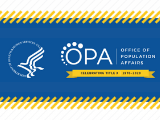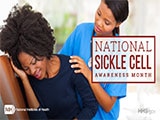Achieving Better Health for Mothers and Babies: Taking Action, Saving Lives
In our work, we see medical innovation almost daily. The advancements made in neuroscience, bionics and trauma care would be considered miracles to physicians 100 years ago – let alone 10 years ago. Despite many giant leaps forward, our nation continues to struggle with tragic and often preventable deaths related to childbirth.
Poor maternal health and birth outcomes can be found across the country. So too can the assessment that many of these negative outcomes can be prevented. Take the story of Dr. Shalon Irving for example. A lieutenant commander for the U.S. Public Health Service Commissioned Corps and an accomplished epidemiologist for the Centers for Disease Control and Prevention, Dr. Irving spent her academic and professional career examining the root causes of illness. She was a successful woman at the peak of her profession who had access to the very best care, not to mention a personal and professional network filled by equally talented physicians and researchers. Despite all these advantages, Dr. Irving experienced complications from high blood pressure and died just a few weeks after the birth of her beautiful baby girl.
Her story is part of an alarming trend. While other nations have reduced their maternal mortality rates, the U.S. has seen it rise in recent years. Today, American women are 50% more likely to die from childbirth and pregnancy-related complications than their own mothers. African American mothers are three times more likely to die in childbirth than Caucasian mothers. For every woman we lose to complications from pregnancy or birth, nearly 100 more experience severe, life-threatening complications including hemorrhage, infection, uncontrolled blood pressure and blood clotting disorders.
State mortality data has demonstrated that most pregnancy-related deaths are preventable. Cardiovascular disease is now the leading cause of death in pregnancy and the postpartum period, constituting nearly 30% of pregnancy-related deaths. Chronic hypertension – which is diagnosed or present before pregnancy or before 20 weeks gestation – may result in significant maternal, fetal, and neonatal morbidity and mortality. The rate of chronic hypertension increased by 67% from 2000 to 2009, with the largest increase (87%) among African American women. CDC points to hypertensive disorders, cerebrovascular accidents, and other cardiovascular conditions as some of the leading causes of maternal deaths, all potentially preventable conditions. It is imperative to identify risk factors prior to pregnancy in order to prevent poor pregnancy and postpartum outcomes. We must ensure the health of America’s mothers before, during, and after pregnancy to keep them and their babies safe and healthy. We must do better. We must band together with all members of a maternity care team at the national, state and community levels to dramatically reduce the risk for mothers and their babies.
As a healthcare leader, now is the time to work with your board, leadership team, clinical leaders, care teams, community partners, and mothers to confirm that your hospital is doing as much as possible to improve maternal health.
Here’s how you can start:
First, collect and evaluate your key maternal safety data for hypertension, hemorrhage, infections, primary C-section rate and opioid addiction. Every hospital should have a systematic approach to reviewing maternal health complications, acting on the data as appropriate and implementing improvement strategies. For example, multidisciplinary committees can review data, prioritize key issues, disseminate information, and develop and implement plans to improve visibility and ownership of outcomes. It is also important to ensure risk-appropriate care is provided to both high- and low-risk patients to decrease unnecessary interventions and improve screening and detection of complications.
Second, examine care disparities in your maternal population. Break down your data by place, race, ethnicity and other variables appropriate to your organization and community. Analyze the data over a period of years to help identify disparities and opportunities for improvement in areas, including addressing social determinants of health and maternal health, both prior to and after delivery. African American women’s risk of dying from cardiovascular disease is more than three times higher than that of Caucasian women. Identifying risk factors for pregnancy-related complications prior to pregnancy, specifically those of cardiovascular disease, and ensuring appropriate inventions for optimal blood pressure control could lead to dramatic improvements in disparities. Be sure to check out programs, like this one at the Hospital of the University of Pennslyvania, on using innovation to improve health outcomes of postpartum women with hypertension. Healthcare providers must identify risk factors prior to pregnancy and ensure women are receiving quality prenatal care.
Next, engage mothers and their families as advocates for themselves and others. Empower them to be vocal about their care, and ensure that you have strong referral networks and interventions. For example, a clinical decision support to flag high-risk women in the emergency department, a discharge checklist and home visits for at-risk women can support mothers after delivery and minimize the risk for complications. During pregnancy, many women can feel isolated, removed from extended family and that they lack a strong social support system. Preconception planning and counseling also can help improve maternal health before, during and after pregnancy. The postpartum period is a critical time to keep women connected to care and support.
Finally, partner with clinicians and stakeholders in your community. Engage healthcare providers, community and tactical partners, and other stakeholders in these efforts so that together we can improve maternal health and the well-being of babies and families.
The best health outcomes must be a national priority. We have spent the past 100 years turning back the tide on diseases like polio, smallpox and malaria. We need to redouble our collective efforts to eliminate the preventable causes of maternal mortality and morbidity and to dismantle the foundational factors that result in health disparities. Empowering mothers and their families to speak up and listening to them as partners in their care are important steps in our journey.
Vice Admiral Jerome M. Adams, M.D., is the 20th surgeon general of the United States. Jay Bhatt, D.O., is senior vice president and chief medical officer at the American Hospital Association.
Further Information and Questions:
The AHA’s Better Health for Mothers and Babies initiative gives hospitals and health systems the opportunity to share best practices with the field. If you are an organization interested in supporting the initiative, please contact BHMB@aha.org.
For additional information and resources and to share your story or best practice, visit http://www.aha.org/better-health-for-mothers-and-babies.
The Best Valentine’s Day Gift: Saving a Heart
Reflections on the Second Report of the WHO’s NCD Commission


